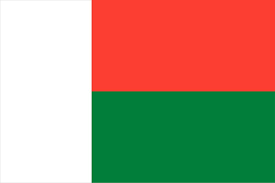Meaning of Colors of Madagascar Flag
What is the Meaning of Colors of Madagascar Flag?
In the heart of the Indian Ocean lies a land of unparalleled biodiversity, rich cultural heritage, and vibrant traditions. Madagascar, the fourth largest island in the world, is a kaleidoscope of colors that captivates the senses and ignites the imagination. From the lush rainforests to the azure waters of the coast, and from the bustling markets to the intricately woven textiles, colors play a significant role in the tapestry of Malagasy life. In this exploration, we delve into the meaning behind the colors of Madagascar, uncovering the cultural significance and symbolism that infuse the island's palette with depth and meaning.
Meaning of Colors of Madagascar Flag
Green: The Color of Abundance and Nature's Bounty
In Madagascar, green reigns supreme, dominating the landscape with its verdant forests, rolling hills, and fertile valleys. As the color of lush vegetation and abundant flora, green symbolizes life, growth, and renewal. It embodies the island's rich biodiversity, from the iconic baobab trees to the exotic orchids that dot the forests. Moreover, green holds cultural significance in Malagasy folklore, where it is often associated with prosperity, fertility, and harmony with nature. From the emerald rice paddies that sustain communities to the deep forests teeming with endemic wildlife, green serves as a reminder of Madagascar's natural wealth and the importance of preserving its ecological balance.
Red: A Symbol of Strength, Passion, and Heritage
In Madagascar, red pulses with vitality, echoing the fiery spirit of its people and the island's tumultuous history. From the vibrant hues of traditional lamba textiles to the crimson earth of the highlands, red holds deep cultural and symbolic significance. It represents courage, resilience, and the enduring spirit of the Malagasy people, who have overcome centuries of colonization, strife, and political upheaval. Red is also associated with ancestral ties and kinship, as seen in the sacred red clay used in ancestral rituals and ceremonies. Moreover, red symbolizes passion, love, and vitality, infusing Malagasy music, dance, and art with energy and emotion. Whether adorning ceremonial attire or adorning the walls of rural villages, red serves as a powerful reminder of Madagascar's rich cultural heritage and the strength of its people.
Blue: The Color of Tranquility, Serenity, and the Boundless Ocean
As an island nation surrounded by the vast expanse of the Indian Ocean, blue holds a special place in the hearts of the Malagasy people. It represents the tranquility of the sea, the endless horizon, and the promise of new horizons. From the azure waters lapping against pristine beaches to the clear skies that stretch overhead, blue embodies a sense of calm and serenity that permeates life in Madagascar. Moreover, blue is associated with spirituality and mysticism, as seen in the vibrant blue pigment used in traditional rituals and ceremonies. It symbolizes the connection between land and sea, heaven and earth, and the eternal cycle of life and renewal. Whether painting the wooden pirogues that ply the coast or adorning the walls of seaside villages, blue serves as a reminder of Madagascar's maritime heritage and its enduring relationship with the ocean.
Yellow: The Color of Sunshine, Joy, and Prosperity
In Madagascar, yellow radiates with warmth, illuminating the landscape with its golden glow and imbuing life with a sense of vitality and optimism. As the color of sunshine and abundance, yellow symbolizes prosperity, fertility, and the promise of a bountiful harvest. From the golden fields of ripe maize to the sun-kissed sands of the coast, yellow evokes a sense of joy and celebration that permeates Malagasy culture. Moreover, yellow is associated with royalty and nobility, as seen in the golden adornments worn by tribal chiefs and dignitaries. It represents power, prestige, and divine favor, reflecting the hierarchical structure of Malagasy society. Whether adorning traditional attire or decorating ceremonial artifacts, yellow serves as a reminder of Madagascar's agricultural heritage and the importance of community and cooperation in achieving prosperity
.
White: The Color of Purity, Spirituality, and Unity
In Madagascar, white exudes purity, simplicity, and the timeless beauty of the natural world. As the color of pristine beaches, towering limestone cliffs, and sacred zebu horns, white symbolizes purity of heart, mind, and spirit. It represents the quest for spiritual enlightenment and the pursuit of harmony with the cosmos. Moreover, white is associated with unity and solidarity, as seen in the white silk scarves exchanged during traditional ceremonies and festivals. It signifies the bonds of friendship, kinship, and mutual respect that bind communities together. Whether adorning ceremonial attire or decorating sacred spaces, white serves as a reminder of Madagascar's cultural diversity and the universal values that unite its people.
Conclusion
In Madagascar, colors are more than mere pigments; they are a reflection of the island's rich cultural tapestry, diverse natural landscapes, and indomitable spirit. From the verdant green of the rainforests to the fiery red of the earth, and from the tranquil blue of the ocean to the radiant yellow of the sun, each hue tells a story of resilience, vitality, and the enduring bond between humanity and the natural world. As we navigate the complexities of the modern age, let us draw inspiration from Madagascar's vibrant palette and strive to cultivate a deeper appreciation for the colors that infuse our lives with meaning, beauty, and wonder.

